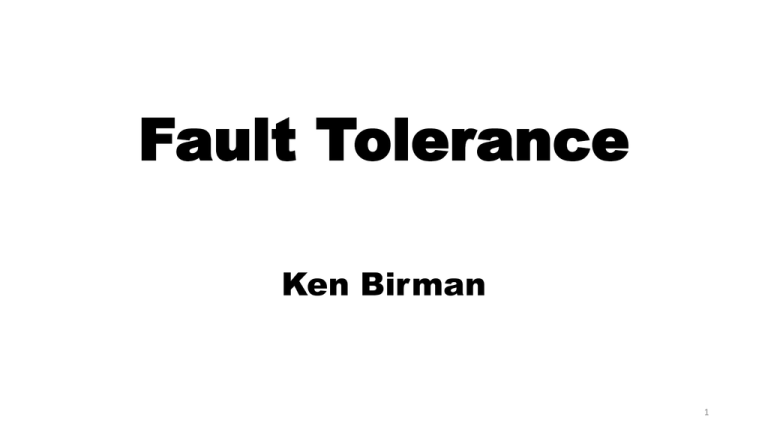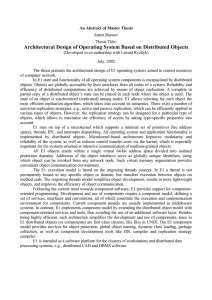Fault Tolerance Ken Birman 1
advertisement

Fault Tolerance
Ken Birman
1
Too many seminal concepts
•
•
•
•
•
Process pairs, primary-backup
2PC and 3PC, Quorums
Atomic Transactions
State machine replication
RAID storage solutions
Theory
• Consensus W: consensus
• FLP
+ oracle
•
•
•
•
•
•
Bonjour!
Lorenzo Alvisi’s Byzantine twin
wants you to use 2f+1 replicas
Checkpoints, Message Logging
Byzantine Agreement
Gossip protocols
Virtual synchrony model
Paxos
Zookeeper
… Skepticism
• CATOCS
CAP
2
Quicksilver
Sender
based
Snapshot
Serializability
Unified
RAID
Hypervisor
Nested
Transactions
Argus
QuickSilver
Receiver
Zookeeper
based
VM
chkpts
Chubby
Fawn
Checkpoint
Rollback
LINQ
Transactions
2PC
3PC
Quorums
Storage Isolate,
recover from
Solutionsdriver faults
VIA
Infiniband
Dryad Fault
Isolation
Recovery
Blocks
Paxos
Zookeeper
Bimodal
Multicast
Isis
BAR
Gossip
ZYZZYVA
PRACTI
State Machine
Replication
U-Net
Gossip BFT
IPMC
RDMA
Verbs
Consensus
Capability
Based
Methods
Time,
Clocks
Chain
Replication
Linearizability
Thor
Transis
Protocol Building Blocks
OS Infrastructure and Tools
• Too much for 25 minutes…
• Focus on state machine replication with crash failures
3
Fault-Tolerance via Replication: Rich History
• Early debate about the question itself
• Some believed that the OS layer is the wrong place to
offer strong properties…
• Today that debate has reemerged:
• Some believe that the cloud can’t afford strong properties!
4
Theory
5
Basic questions
• What sort of system are we talking about?
• What do we mean by “failure”?
• What does “tolerating” mean?
6
Thinking of Fault-Tolerance in terms of Safety
• Consistent State: A system-specific invariant: Pred(S)
• S is fault-tolerant if:
S maintains/restores Pred(S) even if something fails
• Normally, we also have timeliness requirements.
7
Principles from the theory side…
• FLP: Protocols strong enough to solve asynchronous consensus
cannot guarantee liveness (progress under all conditions).
• If running a highly available database with network partition,
conflicting transactions induce inconsistencies (CAP theorem).
• Need 3f+1 replicas to overcome Byzantine faults
8
Systems
9
Principles from the systems side…
• Make core elements as simple as possible
• Pare down, optimize the critical path
• Captures something fundamental about systems.
Butler
Jerry
• Generalized End-to-End argument:
• Let the application layer pick its own models.
• Limit core systems to fast, flexible building blocks.
B. Lampson. Hints for computer system design. ACM Operating Systems Rev. 1983.
J. Saltzer/D. Reed/D. Clark. End-To-End Arguments in System Design. 1984.
Dave
10
Dave
Gray: How do systems really fail?
• Studied Tandem’s “non-stop” platforms
Failures caused by bugs, user mistakes, poor designs.
Few hardware failures, and nothing malicious.
Jim Gray
• Jim’s advice? Focus our efforts on the real needs
J. Gray. Why Do Computers Stop and What Can Be Done About It? SOSP, 1985.
11
Tensions
Why aren’t existing OS mechanisms adequate?
Is fault-tolerance / consistency too complex or costly?
Do the needed mechanisms enable or impose models?
12
Do we need fault-tolerant replication?
• Not just for making systems tolerant of failures
• Cloud computing: Provision lots of servers
• Performance-limiting for many machine-learning systems
• So we agree, hopefully: replication is awesome!
• But is there a core OS mechanism here?
13
It comes down to performance and scalability
• As systems researchers, abstracted properties are…
• Useful when designing and testing
• Valuable tools for explaining behavior to users
• Not obstacles: “Impossible” problems don’t scare us…
• Performance is a more fundamental challenge
• Can fault-tolerance mechanisms be fast?
14
Existing core OS support: Inadequate
• IP multicast just doesn’t work…
• Amazon AWS disables IPMC and tunnels over TCP
• TCP is the main option, but it has some issues:
• No support for reliable transfer to multiple receivers
• Uncoordinated model for breaking connections on failure
• Byte stream model is mismatched to RDMA
15
… Higher-level replication primitives?
• Isis: In 1985 used state machine replication on objects
• Core innovation was its group membership model, which
integrates membership dynamics with ordered multicast.
• Durability tools: help application persist its state
• Paxos*: Implements state machine replication (1990)
• A durable database of events (not an ordered multicast)
• Runs in “quasi-static” groups.
*Homework:
16
First version of Paxos protocol?
Delays on the critical path: Isis
Original Isis Tookit:
State machine replication of
user-defined objects.
Durability was optional.
• Oracle
Refactor (‘87)
• Uses quorums
• Outputs “Views”
• Bisimulates Paxos
• Critical Path
Paxos: Many optimizations, often via
transformations like the Isis ones
But Paxos theory and formal
methodology are very clean, elegant...
• Asynchronous, pipelined
• Flush when view changes
• Only pay for properties used
Virtual Synchrony: Model + menu of choices
[Note: CATOCS controversy arose here…]
17
How does one speed such systems up?
© Time Warner Brothers
• Start with simple, easily analyzed solution... Study the code
• The critical paths often embody inefficiencies, like requesting
total order for actions already in order, or that commute.
• Often, synchronous events can be asynchronously pipelined
• Restructure critical paths to leverage your insights
• Hopefully, the correctness argument still holds…
Pattern shared by Isis, Paxos, Zookeeper, Chain Replication, Zyzzyva, many others…
18
… Real systems informed by sound theory
• Isis: Widely adopted during the 1995-2005 period
• French ATC system, US Navy AEGIS, NYSE...
• Paxos: Very wide uptake 2005-now
• Locking, file replication, HA databases…
• Clean methodology and theory appeal to designers
• Corfu is the purest Paxos solution: robust logging
19
CATOCS: A case against consistent replication
• Too complex
• Violates End-to-End by imposing
model on the user
• No matter what form of update order
is supported, user won’t like it
• Ordering is just too slow, won’t scale
Dave Cheriton
Dale Skeen
20
So were CATOCS claims true?
• Early replication solutions really were too slow.
• Later ones were faster, but more complex.
• But CATOCS analysis of ordering was dubious.
• Yet… what about that missing low-level building block?
• … a puzzle (we’ll come back to it later)
21
Chain replication
Chubby
Isis2
The “consensus” family…
Horus
Ensemble
Paxos
Corfu
Isis
Transis
W
consensus
Viewstamped
Replication
JGroups
Zookeeper
• Can transform one to another… optimizations driven by
desired properties.
• For me, durability remains puzzling
• Is the goal durability of the application, or of its “state”?
22
… a few winners:
• State Machine Replication, Paxos, ACID transactions
Conceptual
Tools
• Chubby, Zookeeper, Corfu
Real Systems
• Primary + Warm backup… Chain Replication
23
Servers: 3-5 nodes
A cloud-hosted service could
run on 5,000 nodes in each of
dozens of data centers
Meanwhile, along came a cloud!
24
… Cloud rebellion: “Just say no!”
Werner Vogels
• State Machine Replication, Paxos, ACID transactions
Conceptual
Tools
• Chubby, Zookeeper, Corfu
Real Systems
• Primary + Warm backup… Chain Replication
• Dynamo: Eventual consistency (BASE), NoSQL KVS
ACID
25
Is consistency just too costly?
Eric Brewer
• CAP: Two of {Consistency, Availability, Partition-Tolerance}
• Widely cited by systems that cache or replicate data
• Relaxed consistency eliminates blocking on the critical path
• CAP theorem: proved for a WAN partition of an H/A database
• BASE (eBay, Amazon)
• Start with a transactional design, but then weaken atomicity
• Eventually sense inconsistencies and repair them
26
… but does CAP+BASE work?
• CAP folk theorem: “don’t even try to achieve consistency.”
… meaning what?
• “Anything goes”? “Bring it on?”
• Einstein: “A thing should be as simple as possible,
but not simpler.”
27
… but does CAP+BASE work?
• CAP folk theorem: “don’t even try to achieve consistency.”
• CAP + BASE are successful for a reason:
• In the applications that dominate today’s
cloud, stale cache reads have negative utility
but don’t cause safety violations.
• In effect a redefinition, not a rejection, of consistency
28
A fascinating co-evolution
• The cloud fits the need; the applications fit the cloud.
At first, fault-tolerance wasn’t given much thought.
• Jim Gray :
“Why do systems fail?”
• Today:
Why don’t CAP+BASE systems fail?
Edsger Dijkstra
• Could we apply Dijkstra’s theory of “self-stabilization” to BASE?
Dijkstra: Self-stabilizing systems in spite of distributed control, CACM 17 (11): 1974.
29
Future Shock: Disruption is coming
• Life and safety-critical cloud computing…
• Smart power grid, homes, cities
• Self-driving cars
• Cloud-hosted banking, medical care
• Weakened consistency won’t suffice for these uses.
30
Homework (due date: SOSP 2017)
• Start with a clean slate (but do learn from the past)
• Embrace a modern architecture
• Cloud-scale systems…
• Multicore servers with NVRAM storage
• RDMA (like Tesla’s “insane speed” button).
• Propose a new approach to cloud-scale consistency
31
Future Cloud…
• The O/S has been an obstacle… even embraced inconsistency.
• The future cloud should embrace consistency.
• Key: Elegance, speed, support real needs of real developers
• Need a core OS building block that works, integrated with
developer tools and IDEs that are easy to use.
32





